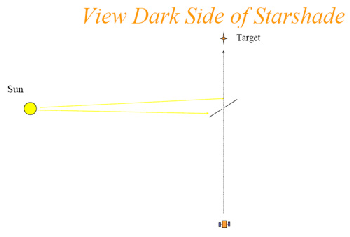
[ Coronagraphs and Occulters ] [ Diffraction ] [ Optics ]
![]()
A starshade, or occulter, is an object that is used in conjunction with a telescope to block out the light of a bright object, allowing observation of a fainter object. For example, during a solar eclipse, the moon occults the Sun. The same idea applies when we raise our hand to shield our eyes from the Sun, in order to catch a baseball.
For a simulation of how the New Worlds starshade works, click here.
![]()
With the discovery of over 200 extrasolar planets over the past decade, the search for life is beginning anew. Recent technological advances have brought new hope for the direct detection of terrestrial extrasolar planets. Using the idea of a starshade and space telescope, Dr. Webster Cash of the University of Colorado at Boulder has proposed a new mission aimed at directly detecting and analyzing extrasolar terrestrial planets.
The telescope and starshade would fly in formation, with the starshade creating a deep shadow for the telescope to sit in. Once in position, the telescope will be able to directly view the entire planetary system, without the starlight hindering the view.
 |
![]()
The problem with direct detection of terrestrial extrasolar planets has been that the light of the parent star is overwhelmingly bright, preventing the much dimmer planet from being observed. However, Dr. Cash has developed a starshade, uniquely-shaped, that successfully eliminates the light from the parent star, allowing the planets to be seen.
The most challenging obstacle is caused by diffraction. Diffraction is the bending of waves around a corner. It applies to all types of waves: light, sound, water, etc. Diffraction explains how we can hear people around corners, or in different rooms. The sound waves bend around corners and are able to reach our ears. The same concept applies to light as well. Thus the starlight hitting the edge of the occulting disc will diffract around the edge and still be visible, defeating the purpose of the occulter.However, the unique shape of the starshade also eliminates diffraction.
For more information on diffraction and the unique shape of the starshade, click here.

The starshade will be tilted so that the telescope sees the dark side – it will see only the very thin leading edge of the starshade illuminated by the Sun.
 |
![]()
When trained on newly forming stars, starshades allow us to directly image the stellar nebula that is forming the new star, but that is already lost in the glare of the bright central object. In addition, starshades can similarly image accretion disks around active galactic nuclei (AGN) where the contrast is currently too great to see the infalling gas against he glare of the central black hole.